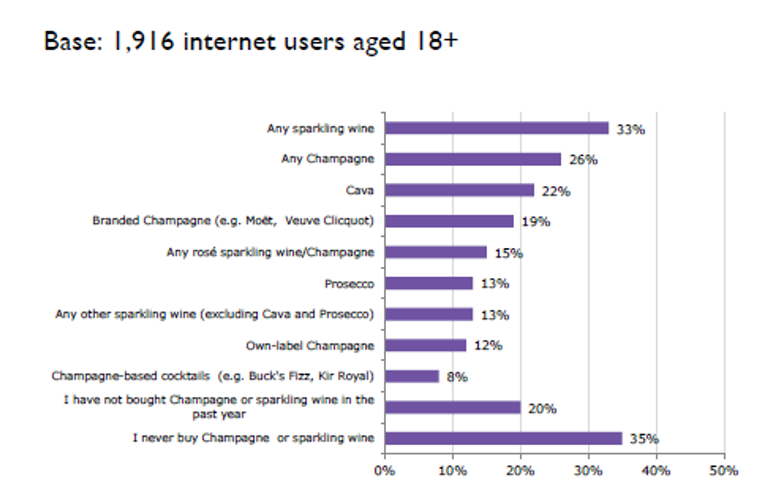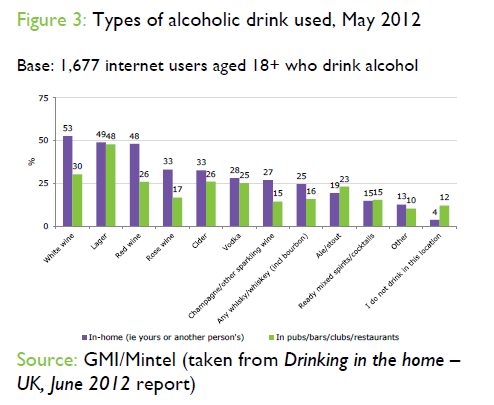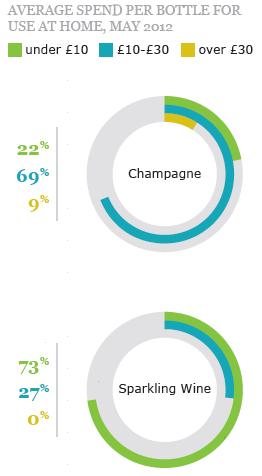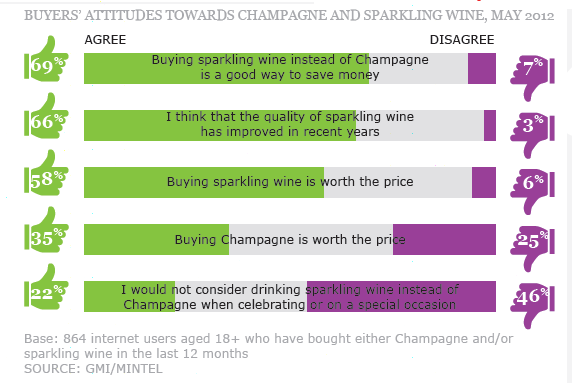Abstract
The goal of this paper was to assist the ESW (English Sparking Wine) organization in creating greater interest and awareness of English sparkling wine both in local markets and abroad. While ESW was successful in outpacing champagne within its local markets, its consumption is still fairly limited due to competition from red wine, white wine and lager.
Introduction
Based on Mintel research data which has examined the impact of English sparkling wine (ESW) since it entered the market, 69% percent of present day consumers within the UK prefer sparkling wine compared to champagne. In fact, a gradual progression has been shown wherein since 2007 there have been more sparkling wine sales in the country as compared to champagne by a factor of 18 percent. This shows growing demand within the UK yet, when taking into consideration the rest of the wine market, is indicative of ESW only succeeding in a tiny portion of a much larger industry (Marks 2011). When examining the case of English sparkling wine, it can be seen that the product has a considerable level of potential given the generally positive responses to it as stated by the ESW industry (Marks 2011).
Combined with the increased awareness of the local population regarding the presence of a regionally distinctive type of wine that is unique to England, this would of course result in a considerable level of patriotism resulting in the possibility of increased local sales of English sparkling wine. It is based on this that this paper will examine the economic environment of the English sparkling wine industry, the current business strategies that it has been utilizing and make suggestions based on perceived opportunities that have yet to be tapped.
Environmental and Situational Analysis
Based on research data from Mintel, one of the current problems with English sparkling wine at the present is a lack of sufficient brand development due to its association with British wine. Consumers often think that English Sparkling Wine and British Wine, which is made from imported grapes, is actually the same thing. This is a detrimental association since the quality of British wine is towards the lower end of the spectrum as compared to its locally grown counterpart. This is indicative of the necessity of further brand development to the extent that consumers need to know the difference otherwise the association could damage the brand’s reputation in the long run (Marks 2011).
The main weakness of the ESW industry and the wine that it promotes is the fact that it is entering rather late “into the game” so speak when taking into consideration the presence of numerous international wine brands from Europe and even the U.S. (Hilger, Rafert & Villas-Boas 2011). When taking into consideration the amount of time these brands have had in establishing their respective markets, it can be seen that English sparkling wine has a long way to go due to the already overly saturated wine market
Research Aim
To increase the general awareness of English sparkling wine to domestic and international consumers.
Research Objectives
- To examine the current method of marketing utilized by the English Sparkling Wine Industry.
- To create an effective means of enticing the target population to purchase English sparkling wine on the basis of taste, convenience and novelty as compared to other types of wine.
Data Collection Methods
The primary means of data collection that will be utilized in this study will be from Mintel reports that have examined the English sparkling wine industry. Secondary sources will consist of academic journals that delve into different economic theories and the wine industry as a whole. It is anticipated that through this method of data collection, a broad understanding of the current viability and economic environment of the English sparkling wine industry can be developed.
Case Analysis
The theory of utility revolves around the concept of the perceived value that a consumer/client derives from the consumption or use of a particular commodity or service. Within the context of this case analysis, two distinct factors need to be taken into consideration:
- The first being that English sparkling wine is a consumer good.
- Secondly, its consumption has diminishing returns for its consumers since unlike utilities such as electricity and water; there is a finite amount of English sparkling wine that can be consumed by a single individual.
This analysis thus takes into consideration the consumption of other types of alcoholic beverages by consumers and how this may impact demand for English sparkling wine locally (Parker 2004). To understand the demand side of ESW market consumption, the theory of utility uses two distinct methods of measurement, namely Total Utility (TU) and Marginal Utility (MU).
Total utility can defined as the total level of satisfaction that a consumer can get from the use/consumption of a particular good or service, this comes in the form of consumers buying ESW or other types of wine. On the other hand, marginal utility is basically described as an add-on, namely it is the additional form of satisfaction that a consumer can get from the use/consumption of an added portion of a particular good or service.
To illustrate this point, one can imagine a person buying a bottle of English sparkling wine at wine store due to some sort of celebration (ex: Christmas, New Years, Boxing day, etc.) (Bicknell & MacDonald 2012). While initially the total utility and marginal utility are equal, if the person were to go back and kept on buying the same product for that day or for another celebration, the total utility would increase due to the consumption however the marginal utility would decrease over time as a result of the continuous consumption of the same product. This is based on notion that continuous consumption of the same product would eventually cause a person to get tired of consuming it, thus, the added value continues to decrease over the course of consumption.
For example, within the UK the consumption of champagne has normally been correlated with having it during special occasions or during some sort of celebration. However, this practice has continued for quite some time over the years and has resulted in a decrease in champagne’s marginal utility (Bouzdine-Chameeva & Galam 2011). Evidence of this decrease in marginal utility can be seen in the Mintel report below:

As it can be seen, sales of sparkling wine within the UK have shown a considerable increase within the past few years and Mintel data has shown that it has beaten Champagne in the local market by 8%. The reason behind this is connected to growing brand awareness, general taste and growing popularity in the local market (Bouzdine-Chameeva & Galam 2011). This means that English sparkling wine has the potential to go beyond the current local market and encapsulate a wider international audience. Another way of interpreting the report is that the overall marginal utility that consumers have been deriving from champagne over the years has steadily decreased.
Since ESW is being marketed as a more affordable alternative to champagne and the fact that the marginal utility of champagne has been decreasing over the years, this shows how the theory of utility is on the side of ESW since clearly it is beating champagne within its local market. This is not to say though that ESW has no problems expanding in its current market. As the next section will show, ESW has had considerable issues with competitors resulting in an inability to expand out of its current market niche.
Barriers to Expansion: Rational Behavior and Consumer Preference

The following data from Mintel shows that English Sparkling wine has a considerable level of local competition and controls only a small portion of the local wine market as compared to other types of wine. The inherent problem is the fact that other brands have simply been around longer resulting in better brand awareness. To understand how this impacts the capacity for the ESW industry to continue to be competitive, the theory of rational behavior will be utilized a means of examination. The primary idea behind the concept of rational behavior is that consumers are rational individuals who will try to derive the highest amount of utility from the service/product that they patronize. Within the context of this paper, this comes in the form of the consumption of ESW versus other wine brands.
This rational behavior is based on the fact that consumers will act in an economically competent manner in that they will not spend too much money on irrational purchases or services. This can take the form of stockpiling unneeded products or choosing certain services that are well beyond their budgetary means. One of the current issues within the UK at the present has been a declining economy which, when combined with intense local competition, creates numerous issues for the ESW industry since under the concept of rational behavior, it is unlikely that consumers would purchase an item that they cannot afford at the present or are hesitant to purchase due to the uncertain economic climate.
As such, the concept of rational behavior assumes all consumers engage in rational buying behaviors which becomes the basis for any future analysis of consumer patronage towards a particular type of product or utility. It is within the context of the current economic issues within the UK that it is unlikely that under the concept of rational behavior that a considerable increase in the amount of ESW will be bought. Another factor that should be taken into consideration when examining the chart above is the concept of preferences which is based on the fact that each individual consumer has his/her own personal preference towards a particular service or product that is currently available in the market from which they are able to derive the greatest amount of total utility/ satisfaction.
It is due to such a concept that red wine, white wine, lager, cider and vodka dominate the UK market since they are undoubtedly the “preferred” drink of consumers when it comes to any event and are not limited to celebration and special occasions. While an oligopoly of distributors does not exist within the UK wine market, there is an oligopoly in terms of the types of alcoholic beverages that are overwhelmingly consumed by the local population which is limited to lager, red wine and white wine (Agarwal, Ellig & Zywicki 2004). The reason behind this is connected to the concept of consumer preferences and total utility wherein UK consumers simply prefer those types of alcoholic beverages as compared to others. As a result, this limits the capacity for ESW to expand beyond its current competitive landscape aside from beating champagne.
Market Strategy of ESW
Under the concept of budget constraints, each consumer is assumed to have a fixed and finite income due to the limited amount of work in exchange for income each individual buyer is capable of achieving. In this case, it is assumed that there is unlimited demand for goods and services, however, this is offset by a limited income. Under the concept of prices, each individual consumer is considered part of the total demand that is occurring within a given market. Due to the limited amount of income each consumer is capable of achieving they must choose to obtain the best combination of goods that maximizes their total utility while at the same time remaining within a certain price range. It is within this context that when examining the current demand for ESW within the UK, it can be seen that its price is its primary selling point to consumers (Wei & Xueguang 2011). The following info graphic from Mintel proves this assertion:


As it can be seen, a majority of ESW is under the 10 pound range while a majority of champagne is priced from 10 to 30 pounds. Consumer responses indicate that they prefer ESW as compared to champagne since it is cheaper (Benfratello, Piacenza & Sacchetto 2009). This supports the earlier assertion that due to the current economic climate within the UK and under the concept of rational behavior, consumers would choose a more affordable method of consumption (Bruwer & Buller 2012).
The problem really is the fact the industry’s rivals are simply far too entrenched within their respective markets and have too much of a following in terms of the societal connotation involving their purchase and consumption (Clemente-Ricolfe, Escribá-Pérez, Rodriguez-Barrio & Buitrago-Vera 2012). The end result is that despite its efforts, the industry has had difficulty expanding into its cathartic local markets aside from its competition with champagne which it is winning due to its price advantage (Chahal 2012).
Discussion of Findings
Necessity of Shifting to New Consumer Markets
With low consumer spending and an atmosphere of intense market competition which pervades the domestic wine markets within the UK and other parts of Europe, this has resulted in wasteful operational costs for local wine producers within Britain in the form of storage, utilities, taxes, worker salaries and employee benefits for unsold products (Taplin 2012). The fact is, the current consumer market situation within the Britain is not conducive towards sales of new brands of wine and, as such, the ESW industry has suffered as a direct result (Ştefan & Coca 2011). One possible avenue of approach that was determined by this economic examination paper is to shift resources towards foreign wine markets which have not been as badly affected by the current proliferation of brands within Britain and focus efforts there instead.
Possible markets in which the industry could expand include China, Japan and other parts of South East Asia where there is a considerable level of demand for western goods with little knowledge regarding their intricacies (i.e. little information regarding particular wine brands and types) (Parker 2010).
Conclusion
Overall, this paper has successfully delved into the case of the UK English sparkling wine industry and has examined its market environment, current strategies and potential. For the industry to succeed in the future, it is recommended that the guidelines on expansion into new markets that have been outline in this paper be followed.
Reference List
Agarwal, A, Ellig, J, & Zywicki, T 2004, ‘Wine Wars: Uncorking E-commerce?’, Regulation, vol. 27, no. 4, pp. 10-11. Web.
Benfratello, L, Piacenza, M, & Sacchetto, S 2009, ‘Taste or reputation: what drives market prices in the wine industry? Estimation of a hedonic model for Italian premium wines’, Applied Economics, vol. 41, no. 17, pp. 2197-2209. Web.
Bicknell, K, & MacDonald, I 2012, ‘Regional reputation and expert opinion in the domestic market for New Zealand wine’, Journal Of Wine Research, vol. 23, no. 2, pp. 172-184. Web.
Bouzdine-Chameeva, T, & Galam, S 2011, ‘Word-of-mouth versus experts and reputation in the individual dynamics of wine purchasing’, Advances In Complex Systems, vol. 14, no. 6, pp. 871-885. Web.
Bruwer, J, & Buller, C 2012, ‘Consumer Behavior Insights, Consumption Dynamics, and Segmentation of the Japanese Wine Market’, Journal Of International Consumer Marketing, vol. 24, no. 5, pp. 338-355. Web.
Chahal, M 2012, ‘Luxury fizz pops its sparkling magic in growing market’, Marketing Week (01419285), vol. 35, no. 48, p. 10. Web.
Clemente-Ricolfe, J, Escribá-Pérez, C, Rodriguez-Barrio, J, & Buitrago-Vera, J 2012, ‘The potential wine tourist market: the case of Valencia (Spain)’, Journal Of Wine Research, vol. 23, no. 2, pp. 185-202. Web.
Hilger, J, Rafert, G, & Villas-Boas, S 2011, ‘Expert opinion and the demand for experience goods: an experimental approach in the retail wine market’, Review Of Economics & Statistics, vol. 93, no. 4, pp. 1289-1296. Web.
Marks, D 2011, ‘Competitiveness and the Market for Central and Eastern European Wines: A Cultural Good in the Global Wine Market’, Journal Of Wine Research, vol. 22, no. 3, pp. 245-263. Web.
Parker, PM 2004, ‘Global Trade Perspective 2005 – Sparkling Wine’, Global Trade Perspective 2005 – Sparkling Wine, pp. 1-106. Web.
Parker, PM 2010, ‘The 2011 Import and Export Market for Sparkling Wine in Asia’, Regional Trade Reports, p. N.PAG. Web.
Ştefan, G, & Coca, O 2011, ‘The competitive environment’s analysis on the wine market’, Agronomy Series Of Scientific Research / Lucrari Stiintifice Seria Agronomie, vol. 54, no. 2, pp. 468-471. Web.
Taplin, IM 2012, ‘Innovation and market growth in a new ‘New World’ wine region: the case of North Carolina’, Journal Of Wine Research, vol. 23, no. 3, pp. 229-246. Web.
Wei, Z, & Xueguang, Z 2011, ‘Status Inconsistency and Product Valuation in the California Wine Market’, Organization Science, vol. 22, no. 6, pp. 1435-1448. Web.